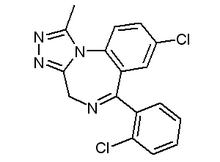Patients with severe COPD commonly suffer from insomnia. However, hypnotic drugs are generally contraindicated in these patients because of their depressant effect on the respiratory centers. New hypnotic drugs with short half-lives are now available. The aim of this study was, therefore, to compare the effects of 2 benzodiazepine hypnotics, T, 0.25 mg (half-life, 2.7 hr) and F, 1 mg (half-life, 19 h), and also of a new drug, Z, 10 mg (half-life), 2.4 h), an imidazopyridine compound, in hypercapnic COPD patients. Nine COPD patients (mean [PaO.sub.2] 60 [+ or -] 5 and mean [PaCO.sub.2] 48 [+ or -] 7 mm Hg) gave their oral informed consent and were studied in stable state. In all the patients, the following measurements were performed: [PaO.sub.2] and [PaCO.sub.2] minute ventilation (Ve), and mouth occlusion pressure ([P.sub.0.1]). Rebreathing [CO.sub.2] tests with Read's method were also performed, and the slopes of the changes in Ve and in [P.sub.0.1] while increasing [PaCO.sub.2] ([delta] Ve/[delta][PaCO.sub.2] and [delta] [P.sub.0.1]/[delta][PaCO.sub.2]) were calculated. The measurements were performed in a randomized double-blind fashion, each patient receiving 1 of each drug (Z, T, or F) on 3 different days. Each measurement in a given patient was separated by a 1-week interval, a control measurement being performed before each drug administration. Measurements were performed 2 hours after each drug administration, since maximum plasmatic level has been shown to be achieved at that time for the 3.drugs. No difference in [PaO.sub.2], [PaCO.sub.2], Ve, [P.sub.0.1], [delta]Ve/[delta][PaCO.sub.2], and [delta][P.sub.0.1]/[delta] [PaCO.sub.2] was noted between control measurements and 2 hours after administration of T and Z. Two hours after administration of F, a significant difference was noted in [PaCO.sub.2] (50 [+ or -] 6 during control vs 54.5 [+ or -] 7 mm Hg 2 h after F, p < 0.01) and [delta]Ve/[delta][PaCO.sub.2] (0.42 [+ or -] 0.23 during control vs 0.29 [+ or -] 0.21 1. [min.sup.-1] mm Hg 2 h after F, p < 0.01). [PaO.sub.2] also decreased from 60.5 [+ or -] 7 to 57.5 [+ or -] 8 mm Hg 2 hours after F, but this decrease did not reach significance. This study demonstrates that, given at single equivalent doses, hypnotic drugs (T and Z) with short half-lives have no significant effect on arterial blood gases and control of breathing in severe COPD patients, compared with a long-half-life hypnotic (F). Long-term administration of T or Z should, therefore, be evaluated in severe COPD patients, since sleep disturbances are a major problem in these patients.
COPYRIGHT 1990 American College of Chest Physicians
COPYRIGHT 2004 Gale Group



